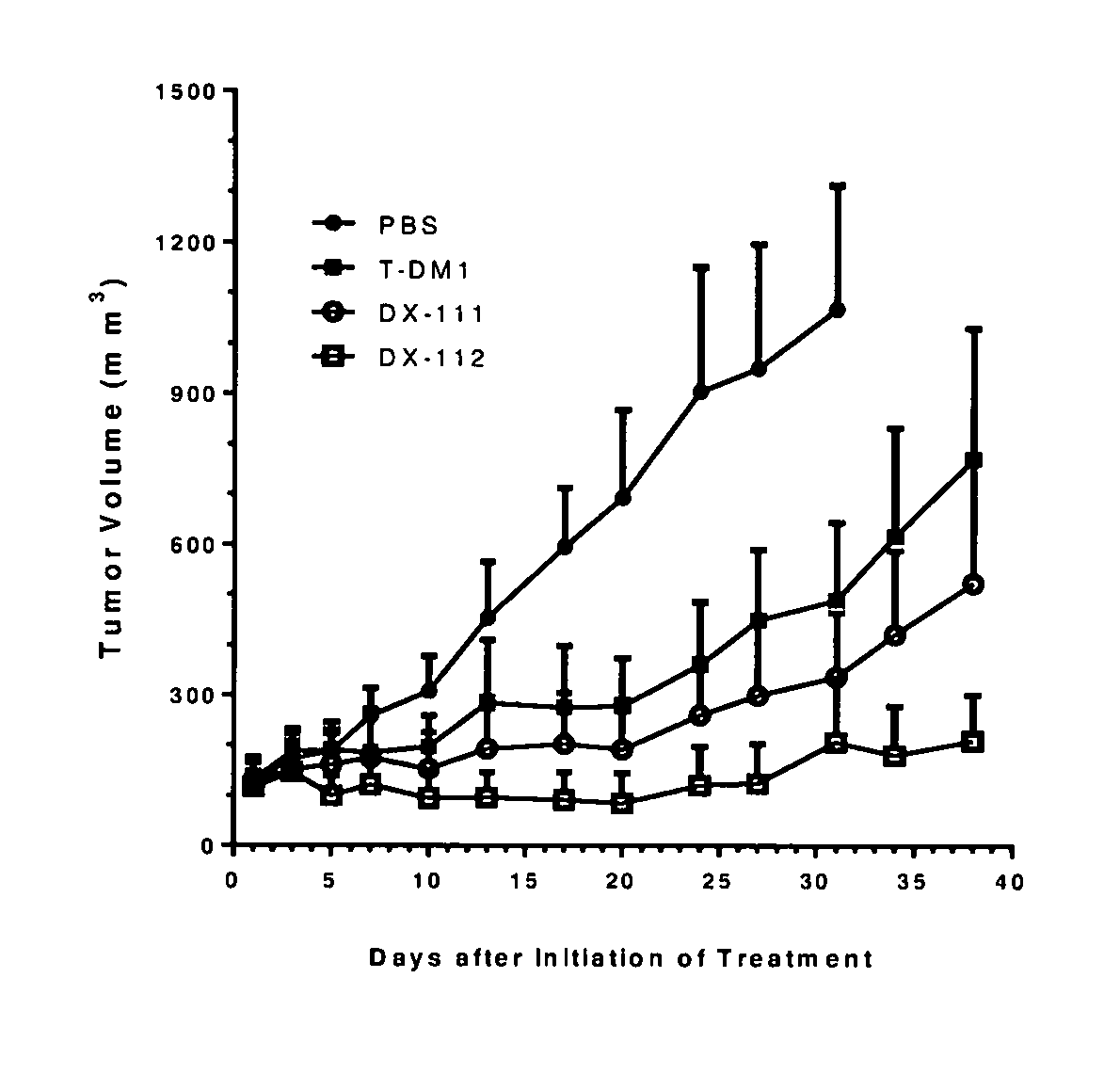Hydrophilic linkers and ligand-drug conjugates thereof
a technology of hydrophilic linkers and ligand-drug conjugates, which is applied in the field of hydrophilic linkers, can solve the problems of poor activity of many adcs in mdr1-expressing cells, cytotoxic drugs are still susceptible to the second type, and the old problem still exists, so as to improve the potency and therapeutic index of ligand-drug conjugates
- Summary
- Abstract
- Description
- Claims
- Application Information
AI Technical Summary
Benefits of technology
Problems solved by technology
Method used
Image
Examples
example 1
3-(2-Chloro-ethanesulfonyl)-propionic Acid
[0179]
[0180]Step 1: A 2 L round bottom flask charged with NaHSO3 (83 g, 0.80 mol) and water (400 mL) were placed in an ice bath. 2-chloroethanesulfonyl chloride (120 g, 0.74 mol) and a solution of NaOH (83 g, 2.08 mol) in water (210 mL) were added slowly at the same time as the contents of the flask was stirred for 1 h. After 0.5 h of stirring, 50% H2SO4 (70 mL, 0.37 mol) was added. The solution was stirred for 1 h at 0˜5° C. Then the reaction mixture was filtered and the filtrate was used of the next step.
[0181]Step 2: A solution of acrylic acid (55 g, 0.76 mol) in water (100 mL) was added to the above filtrate and the mixture was stirred for 10 min. It was placed in a refrigerator for 3 days at 4° C. The mixture was filtered and the residual solid was recrystallized from hot water to give a white powder (50 g, 0.25 mol, 33.7% yield). 1H NMR (500 MHz, MeOD): δ 3.96 (dd, J=8.6, 5.4 Hz, 2H), 3.63 (t, J=7.0 Hz, 2H), 3.49 (t, J=7.3 Hz, 2H), 2.8...
example 2
3-(2-Chloro-ethanesulfonyl)-propionyl Chloride
[0182]
[0183]To a solution of 3-(2-chloroethylsulfonyl)propionyl acid (16.0 g, 80.0 mmol) in thionyl chloride (100 ml) was added DMF (0.5 mL). The mixture was heated at the reflux for 2 h. Then, it was concentrated to afford the title compound (15.8 g, 90.2% yield) as a yellow solid, which was used without further purification.
example 3
3-(2-Chloro-ethanesulfonyl)-propionic acid 2,5-dioxo-pyrrolidin-1-yl Ester
[0184]
[0185]N-Hydroxysuccinimide (6.0 g, 52.1 mmol) was added to triethylamine (5.5 mL, 44 mmol) and acetone (150 mL) in an ice bath. 3-(2-chloroethylsulfonyl)propionyl chloride (9.5 g, 43.3 mmol) in acetone (50 mL) was then added dropwise, and the resulting suspension was stirred for 3 h. Next, the ice bath was removed and it was stirred for an additional 30 min. It was concentrated to about 100 mL. The resulting mixture was poured into ice water (1000 mL) and stirred for 3 min. The precipitate was collected by filtration and dried under vacuum to give the title compound as a white powder (10.3 g, 80% yield). 1H NMR (500 MHz, MeOD): δ 3.94 (d, J=6.9 Hz, 2H), 3.66 (d, J=6.9 Hz, 2H), 3.59 (d, J=7.5 Hz, 2H), 3.23 (d, J=7.5 Hz, 2H), 2.84 (s, 4H).
PUM
| Property | Measurement | Unit |
|---|---|---|
| temperature | aaaaa | aaaaa |
| pH | aaaaa | aaaaa |
| concentration | aaaaa | aaaaa |
Abstract
Description
Claims
Application Information
 Login to View More
Login to View More - R&D
- Intellectual Property
- Life Sciences
- Materials
- Tech Scout
- Unparalleled Data Quality
- Higher Quality Content
- 60% Fewer Hallucinations
Browse by: Latest US Patents, China's latest patents, Technical Efficacy Thesaurus, Application Domain, Technology Topic, Popular Technical Reports.
© 2025 PatSnap. All rights reserved.Legal|Privacy policy|Modern Slavery Act Transparency Statement|Sitemap|About US| Contact US: help@patsnap.com



